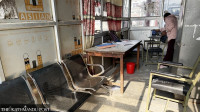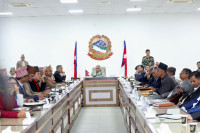National
Foreign aid spending remains poor compared to use of domestic resources
Spending on Asian Development Bank support stands at eight percent and 14 percent in the case of the World Bank in the first half of the current fiscal year.
Post Report
Aid spending by Nepal’s government agencies continues to remain poor with the utilisation of foreign grants and loans standing below 15 percent as of the first half of the current fiscal year.
According to a mid-term review of the budget 2023-24, foreign grant spending stood at just 10.82 percent of the funds allocated under the heading. The spending on foreign loans stood at 13.37 percent of the resources allocated under foreign loans.
During the same period last fiscal year (2022–23), grant and loan spending was 13.01 percent and 11.79 percent, respectively.
Spending on foreign resources has remained poor compared to domestic resources. During the first half of the current fiscal, 36.26 percent of domestic resources were spent, the report said.
Officials said that one reason behind higher spending on domestic resources compared to foreign resources is that most local resources are used as recurrent expenditures—such as salary, pension, administrative costs and fiscal transfer to provincial and local governments.
“It is not that donors’ resources are not used in recurrent expenditures,” said Dhani Ram Sharma, spokesperson for the finance ministry.
“Majority foreign aid is however used in mega projects whose implementation has remained poor, leading to a poor spending of external resources.”
Foreign aid contributes hugely to bridging the resource gap in various government programmes. When the budget was presented in May 2023 for the current fiscal year, the government aimed for Rs242.26 billion in foreign loans and Rs55.45 billion in foreign grants while revenue collection was expected to reach Rs1.49 trillion.
According to Sharma, a huge amount of foreign resources has been allocated for the construction of highways and transmission lines but the pace of implementation of those projects remains slow.
But officials said red tape is also delaying key infrastructure projects.
They pointed out that delays in site clearance by forest and environmental authorities are also slowing down work at infrastructure projects involving both domestic and foreign resources. Besides, donor-funded projects follow a long procedure for hiring consultants and contractors.
“We need a no-objection letter to hire a contractor,” said Sushil Babu Dhakal, director general at the Department of Roads.
“For example, we are evaluating the bids for hiring a contractor to expand the Butwal-Gorusinge road but the evaluation report should go to the World Bank for its approval.”
According to Dhakal, money is not a problem in donor-funded projects but the lengthy procedure for hiring the contractor delays their implementation.
In the case of bilateral aid, usually, only the goods and contractors belonging to the donor country are involved in construction.
For example, the Chinese government is funding the expansion of the Ring Road in Kathmandu Valley. China brings its own contractors and workers to implement the project.
“The work plan in this project is out of our control as the Chinese government implements the project as per its own schedule,” said Dhakal.
The road department is one of the largest recipients of foreign resources as it undertakes the building and expansion of highways. “The contractors failing to mobilise their own resources are also hindering the progress in donor-funded projects,” said Dhakal, the department chief. “The lack of timely availability of construction materials is also hampering the implementation of infrastructure projects.”
According to the mid-term review, spending of resources under the United Nations Children’s Fund (UNICEF) remained poorest—at 0.05 percent of the allocated amount.
Among the major multilateral donors, spending of resources under the Asian Development Bank also remained poor at 8.05 percent during the first half of the current fiscal year while spending of the World Bank’s resources stood at 14.71 percent. These two are the biggest foreign aid providers to Nepal.




 17.12°C Kathmandu
17.12°C Kathmandu














